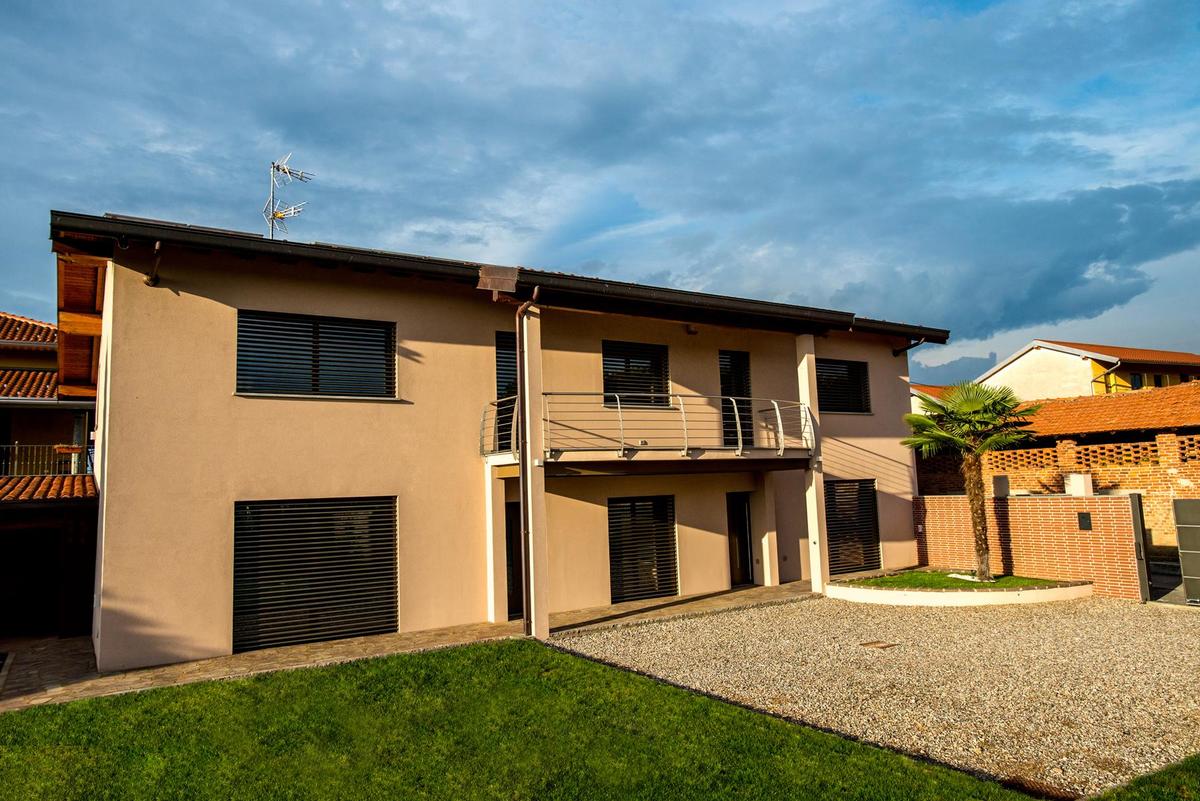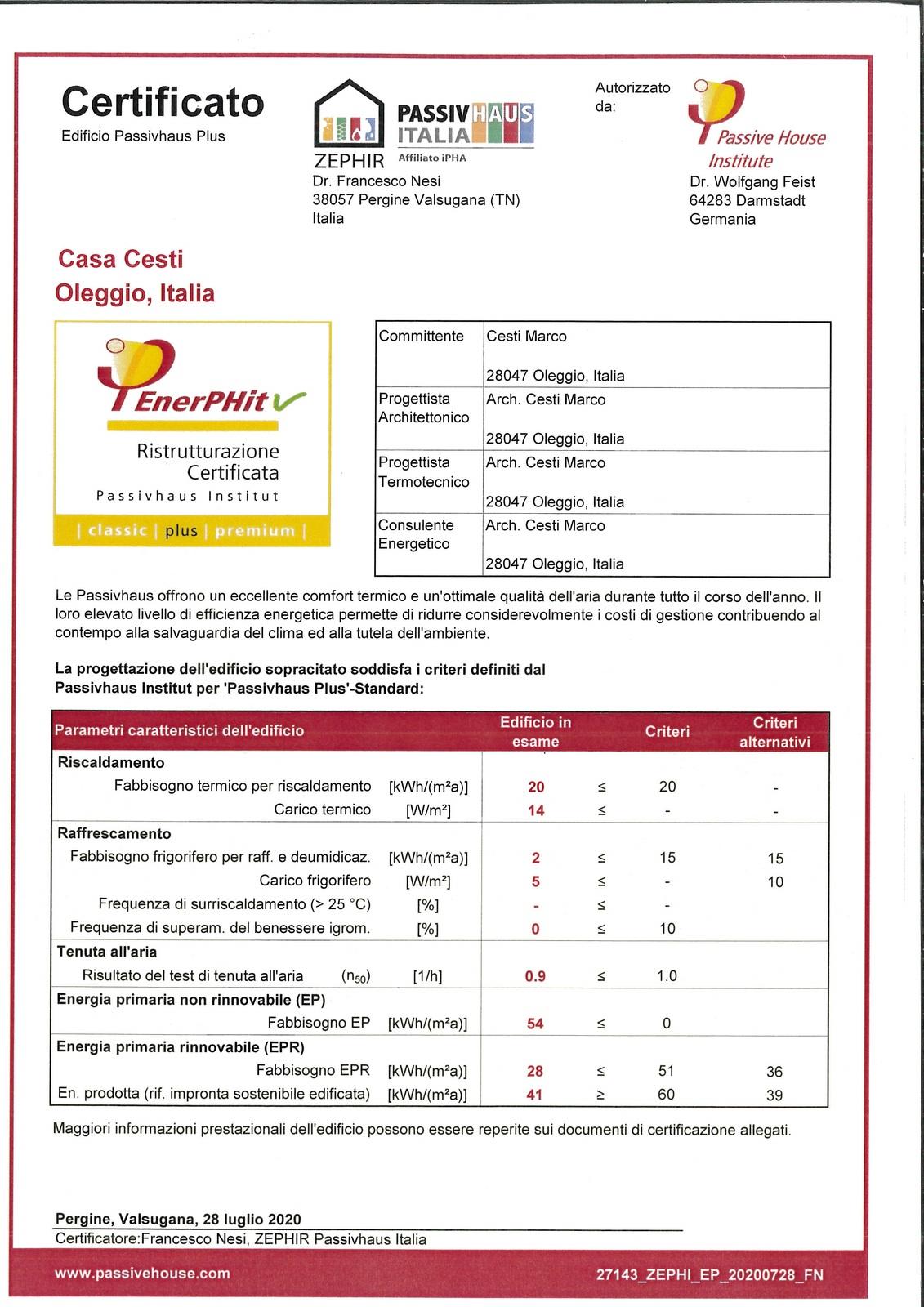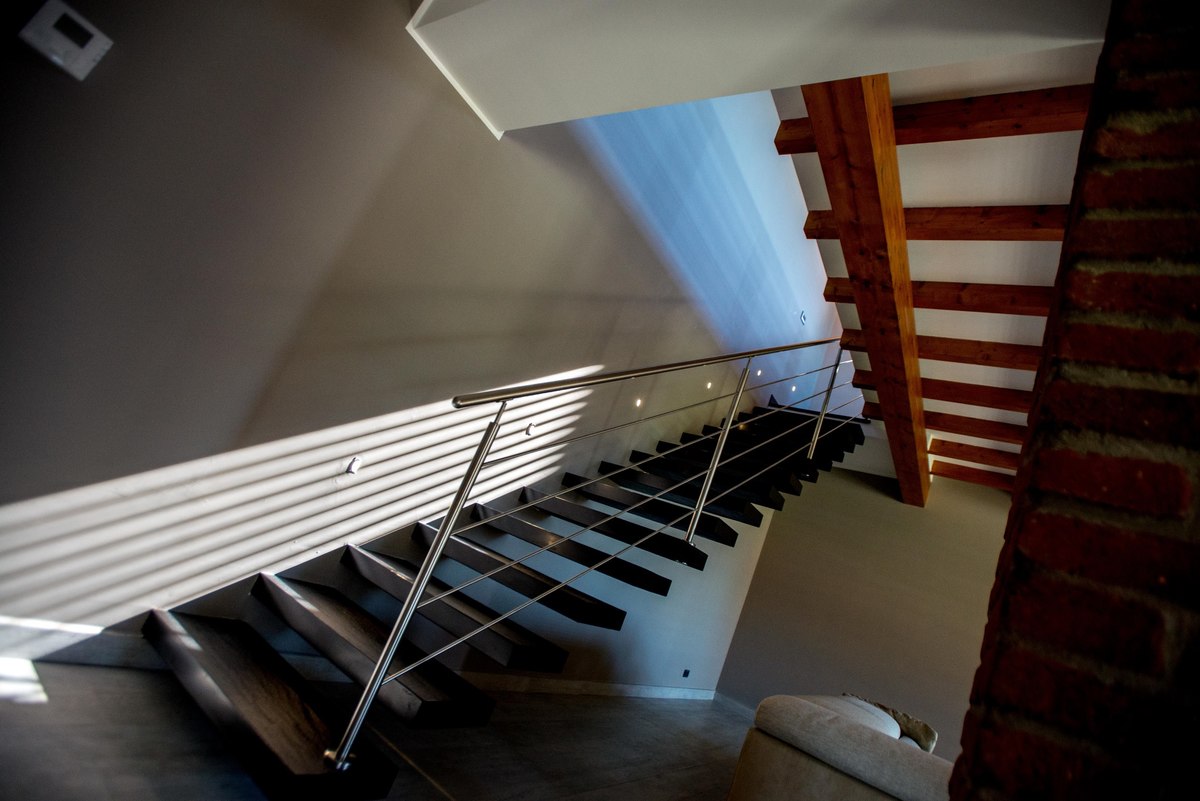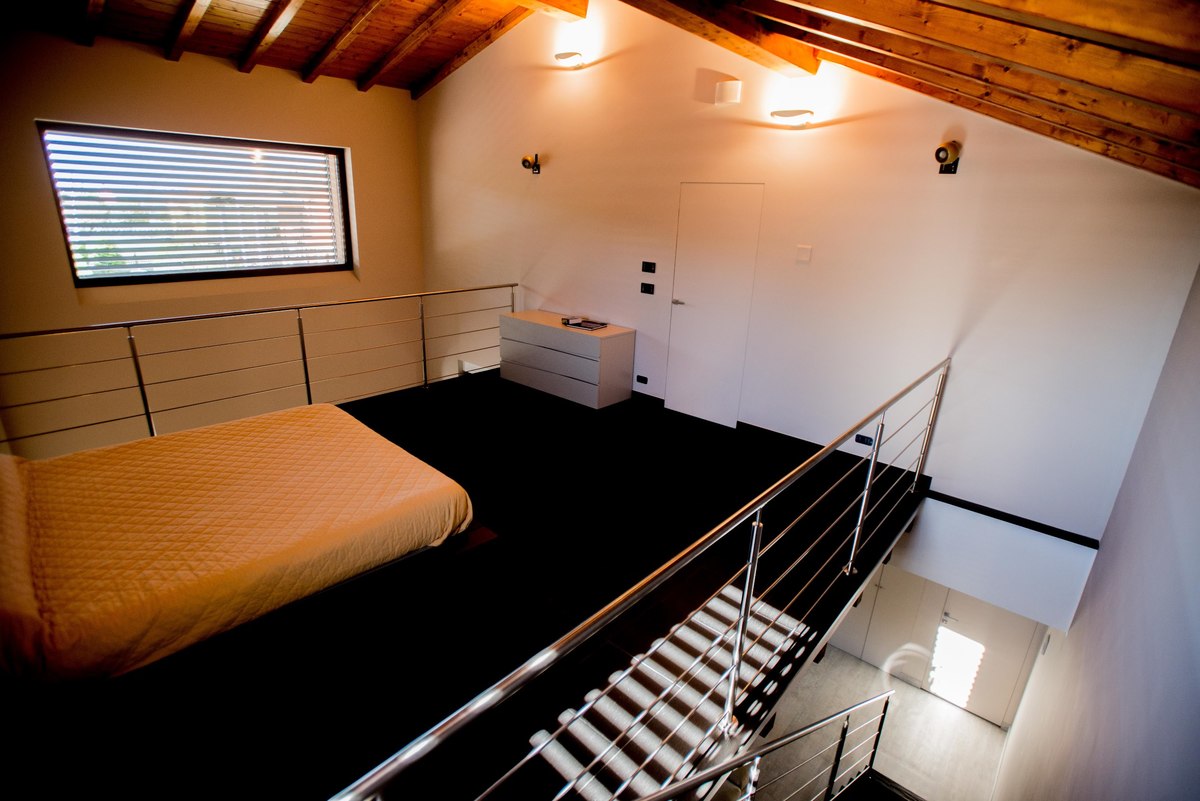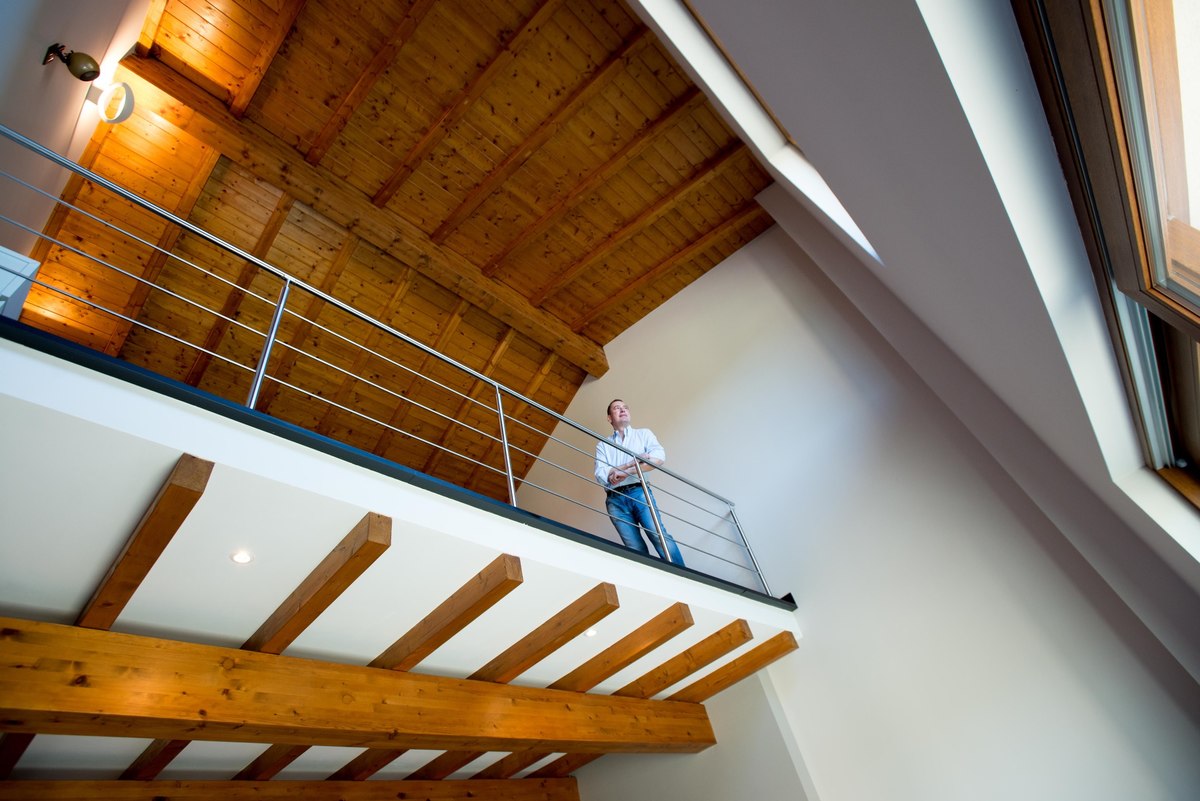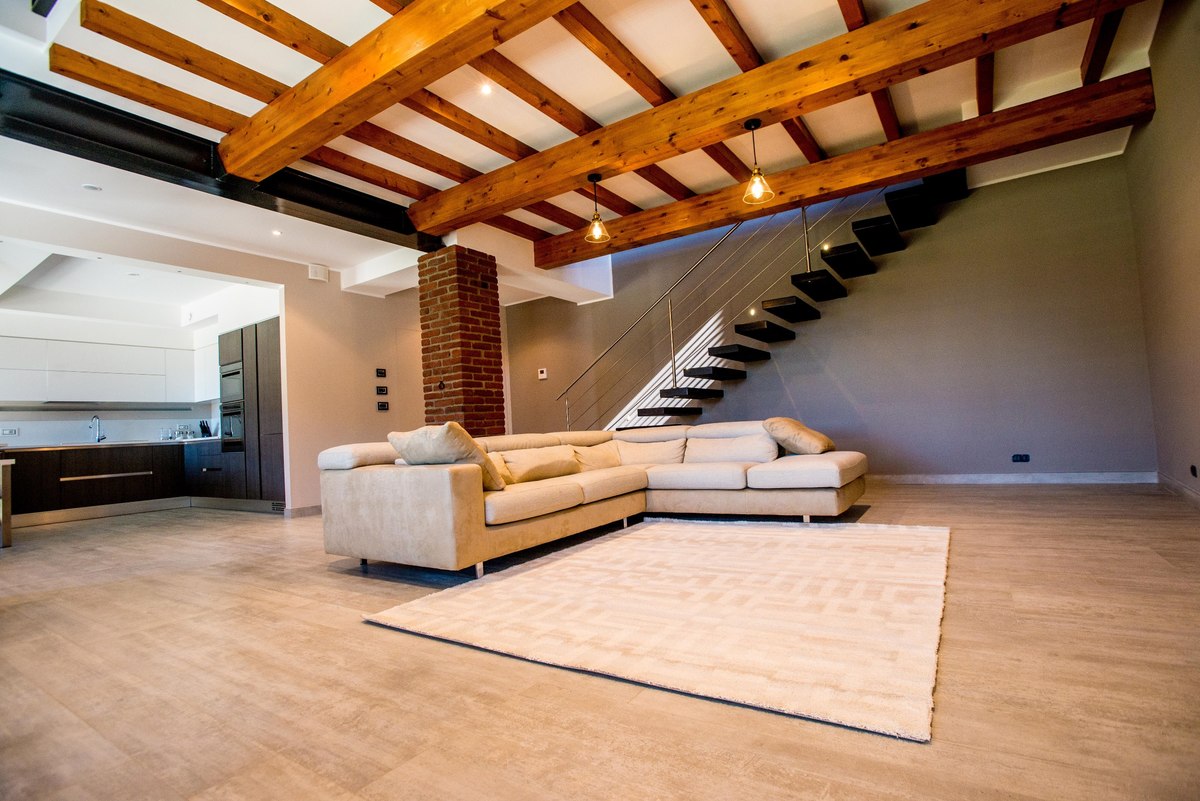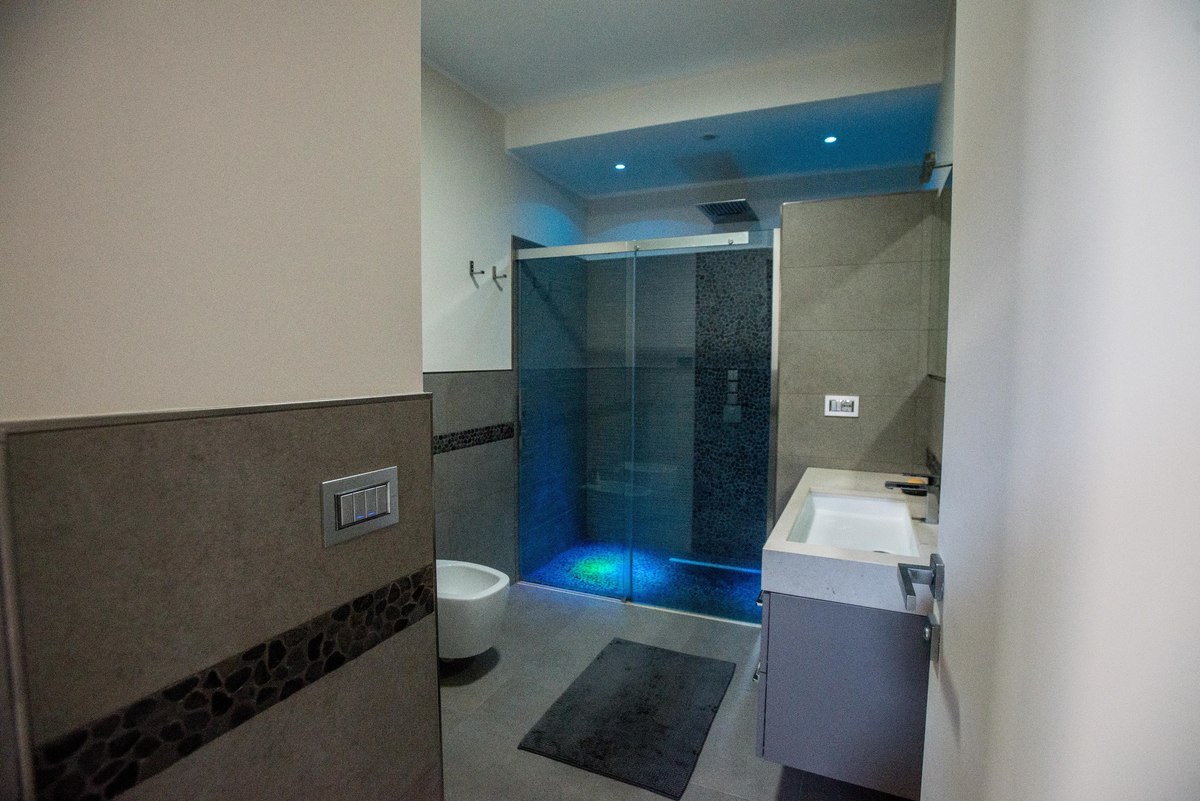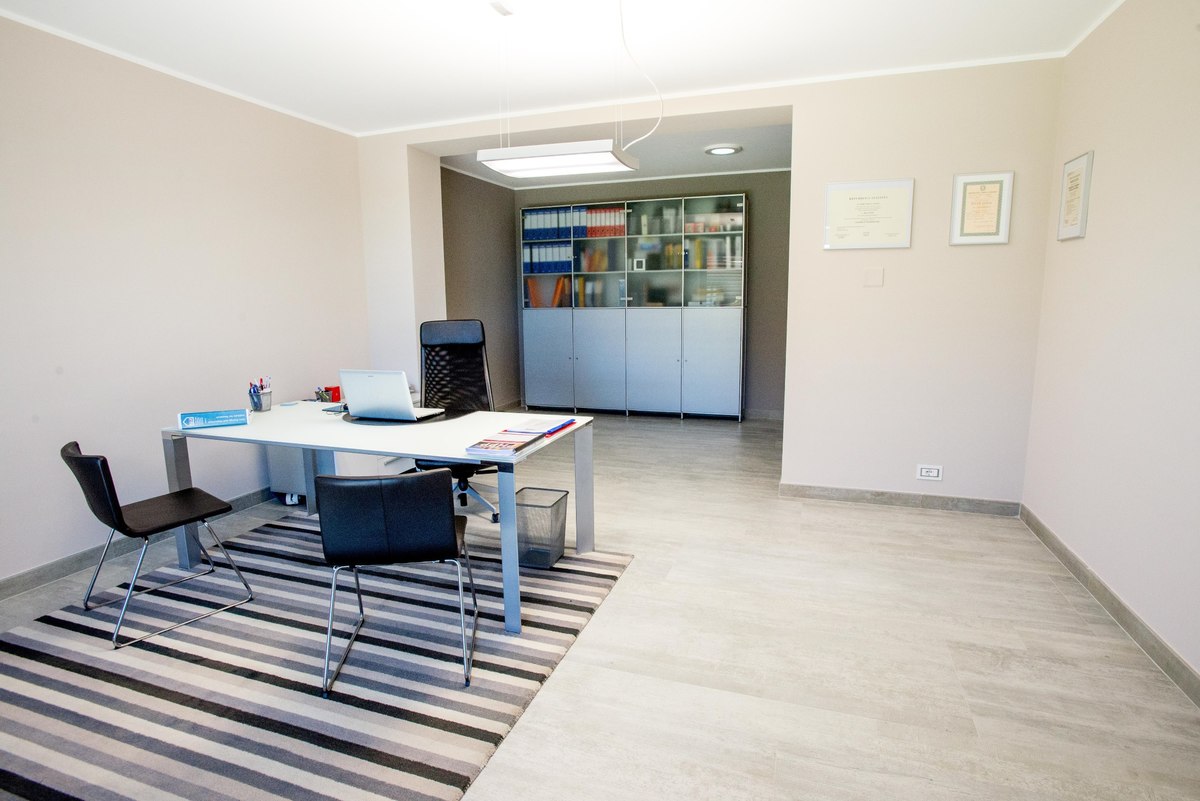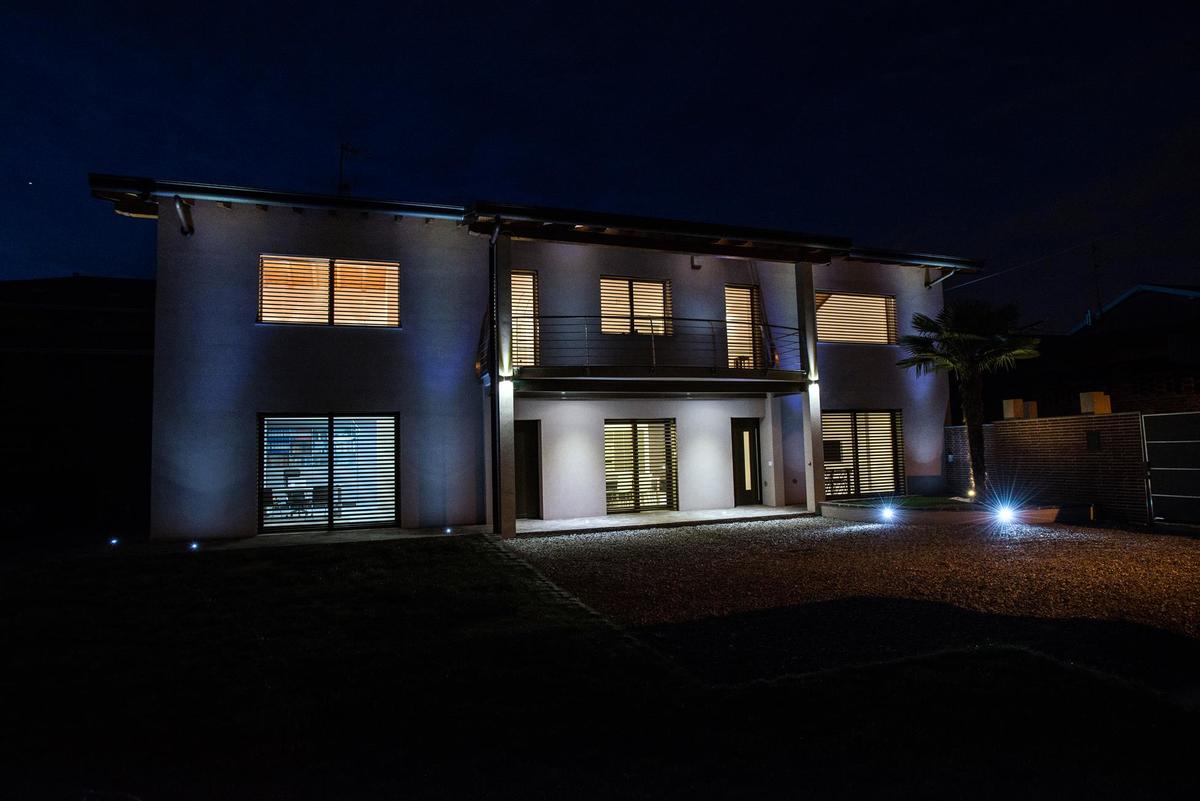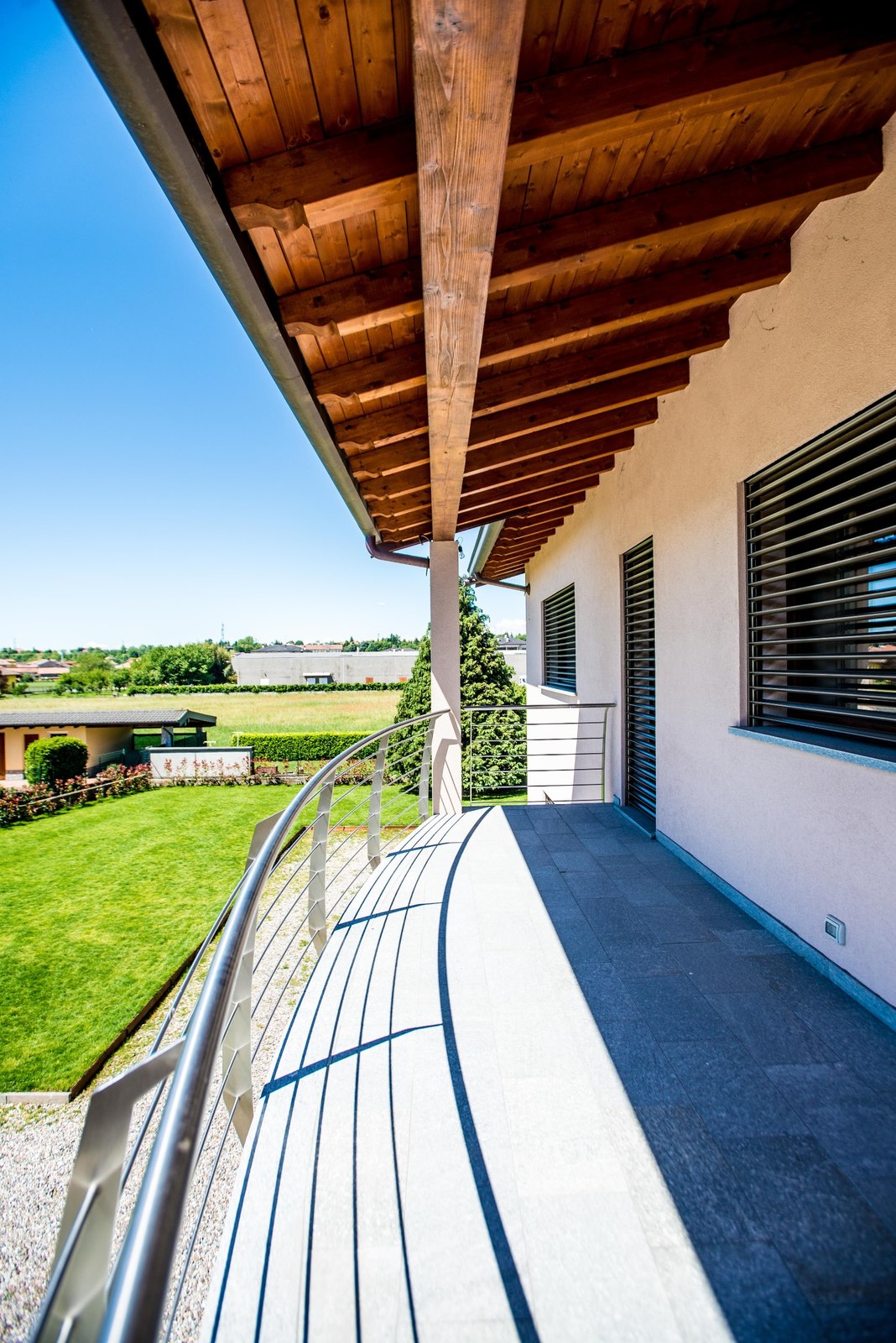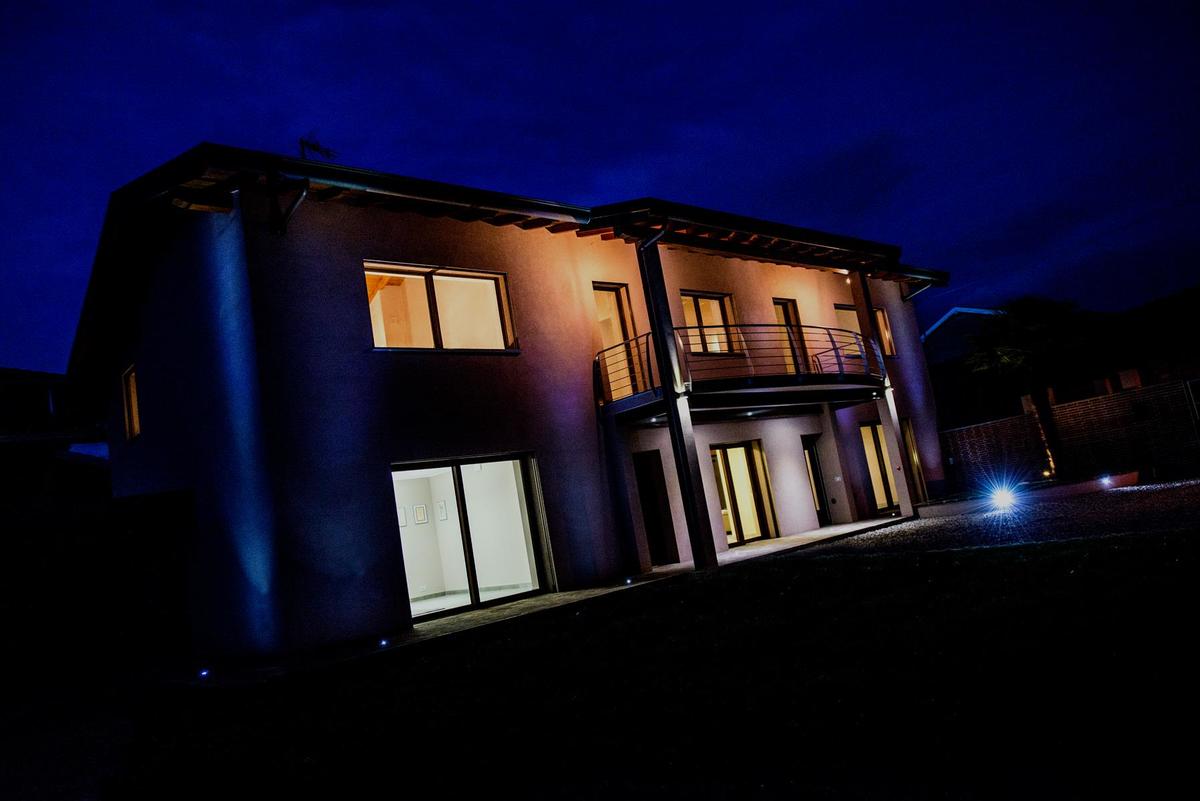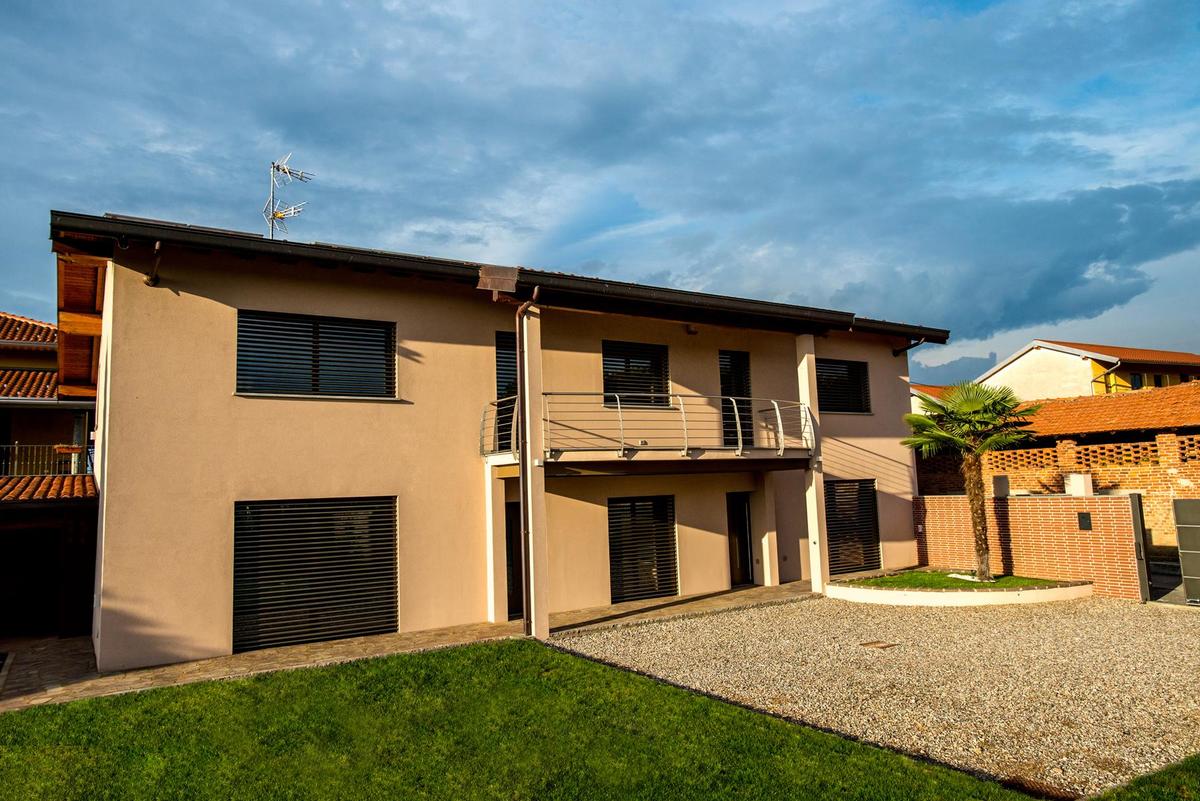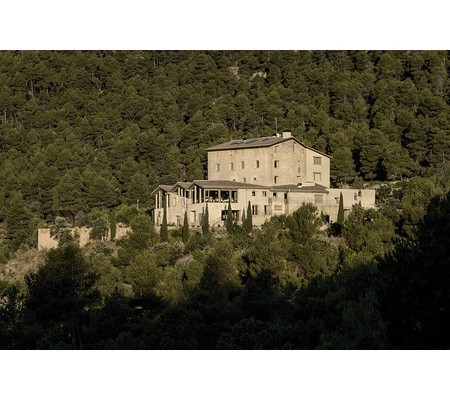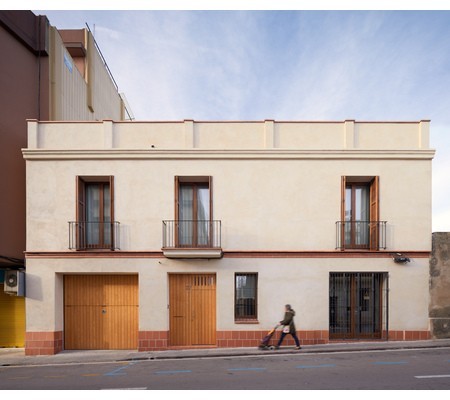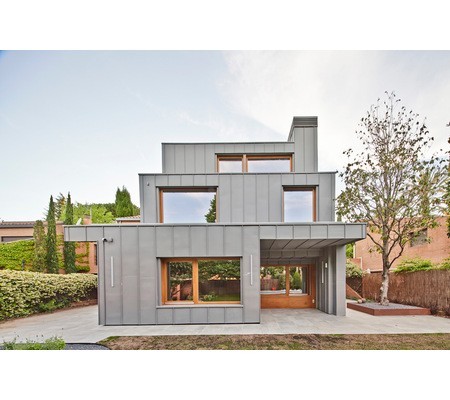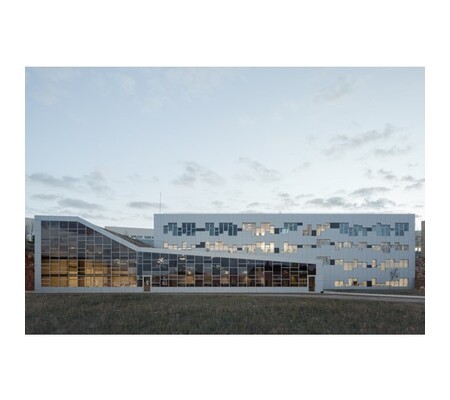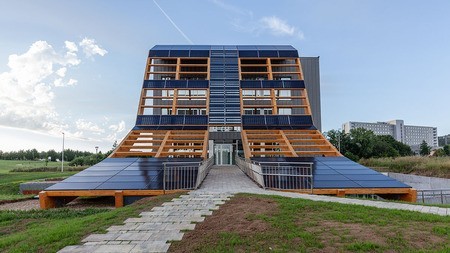Residence "Casa Cesti"- Building nZEB - Oleggio (NO)
Renovation
- Building Type : Terraced Individual housing
- Construction Year : 2012
- Delivery year : 2017
- Address 1 - street : Via Galli 6 28047 OLEGGIO, Italia
- Climate zone : [Cfa] Humid Subtropical - Mild with no dry season, hot summer.
- Net Floor Area : 250 m2
- Construction/refurbishment cost : 330 000 €
- Number of Dwelling : 1 Dwelling
- Cost/m2 : 1320 €/m2
-
Primary energy need
20 kWhpe/m2.anno
(Calculation method : UNI TS 11300 )
The residence called "Casa Cesti" is a complete renovation of an existing dwelling, built on an original building from the early 1900s.
The existing building, typical of the rural area of Oleggio (NO) originally had the constructive features of the classic oak tree farm, ie a stable supporting agricultural activity, oriented mainly along the east-west axis with its main south facing façade , Open on the court spaces and made out of two floors above the ground, with an internal vertical distribution and access to the upper floor areas along an external balcony. The two-sloped roof has different slopes, with the southern slope (slightly inclined) and the northern slope (more accentuated).
The intervention, which could not predict in any way the modification of the existing shape and volume, was oriented to the revision of the existing parallelepiped structure in order to create a "modern farm": an energetically efficient building, designed according to the criteria Of the Phassivhaus Institute, which respects the impact on the outdoor environment through the rational use of clean and renewable energy throughout the life cycle and excluding the use, for any purpose, of fossil fuels, without losing comfort and style for the Its occupants.
The choice of construction materials to be used for refurbishment was immediately geared toward the use of environmentally friendly products, such as the new wood cover with insulation made of wood fiber resulting from machining waste; Rectangular bricks for low conductivity internal counterparts, made of natural material; Internal plastics free from cement and heavy metals; Plaster internal finishes, in order to naturally improve the hygroscopic characteristics of the internal moisture regulation; Thresholds and sills in local stone.
Originally the building was made of brick masonry mixed with stone courses, and was divided into a portion of housing and a portion intended for the manger and shelter of cattle. During the wall consolidation works of the current local cuisine, there were, again, traces of hooks used in the dining room.
The characteristics of the energy redevelopment project were:
• the reduction of energy needs, by taking action on the building envelope in order to minimize heat demand and dispersion;
• Maximize the use of direct solar energy by making large windows on the southern facade that can capture most of the solar solar rays to contribute positively to the thermal balance;
• Use architectural elements such as the gutter and the porch to maximize summer shading on the windows of the foreground and on the inputs, without reducing (as far as possible) the positive contribution of winter solar inputs;
• use an air-ground exchanger in the garden, upstream of the controlled mechanical ventilation system, in order to improve without using energy, the winter, summer, and humidity of the inlet air in the ventilation system of the air- Home improvement, as well as the efficiency of the ventilation system with heat recovery also internal comfort;
• employ a "compact aggregate" machine to fully manage the efficient use of energy, starting from the heat produced by solar collectors, which is used both for heating and hot water production (as needed) as well as For the management of controlled mechanical ventilation, as efficiently as possible;
• use high-performance PVC windows with triple glasses, selected mainly based on the solar factor "g", to improve winter inputs;
• Use an "intelligent" automatic system to adjust the orientation of solar shades to maximize winter solar inputs and reduce overheating in summer, with a logic of operation based on: outdoor weather conditions, indoor indoor temperatures, As well as the habits of occupants of the building.
In order not to waste drinking water, it has been chosen to recover the functionality of the well in place since 1914 to extract water from the first floor present at a depth of 12 to 14 m and use it for irrigation of the garden ( With a requirement of about 2,600 liters per day in the dry season) and for non-food uses such as sanitation, grip points for cleaning solar roof systems and cleaning the yard, creating a building Non-potable water network.
To minimize energy consumption, LED lighting fixtures have been installed for the indoor and outdoor lighting of the building, which are handled for the outside by a twilight sensor associated with careful programming of daily operation. Appliances installed were chosen in classes above the A + and in the building were also located 4 solar tubes to illuminate "naturally" decompressions and blind spots with sunlight captured on the cover.
See more details about this project
https://passivehouse-database.org/index.php?lang=en#d_6413Data reliability
3rd part certified
Contractor
Construction Manager
Stakeholders
Designer
Arch. Marco Cesti
Via Galli 6 - 28074 Oleggio (NO) | Tel: +39.340.2929369 | E-mail: [email protected]
https://www.studiocesti.itConstruction company
A.F. Impresa Edile di Allia Francesco
Allia Francesco | Tel: +39.338.2766317
Construction works Insulators | coverage
Forghieri Massimiliano - Home Automation
Forghieri Massimiliano | Tel: +39.335.6127862
Electrical / home automation / automation
Motti Cesare
Motti Cesare | Tel: +39.349.4909001
Realization of hydro-thermal sanitary systems of heating, cooling and mechanical ventilation
Enercomb S.r.l.
Via Iseo, 56 - 25030 Erbusco (BS) | Tel: +39 030 5311234 | E-mail: [email protected]
http://www.enercomb.it/Supply of ventilation equipment, scaffolds and material equipment Stiebel Eltron
Contracting method
Other methods
Owner approach of sustainability
The primary objective of the project was to build a nZERB building with very low energy consumption and to provide a high level of comfort for occupants, where by simple and "user friendly" domotics all automated daily repetitive functions, such as For example: opening and closing of sunbaths, garden irrigation, façade and outdoor lighting, heating, ventilation and cooling management, trying to incorporate into the logic of the automation program, the activation conditions also related to the habits of the occupants And at local weather events, detected by sensors installed inside and outside the building. This building was the first to be designed and built to high levels of sustainable building and energy efficiency. In the design phase of the daily projects, all the slightest details were taken care of, but it is the execution stage of the yard that required the constant presence on the part of the designer to adapt those that were the detail solutions planned in the project, with the executive feasibility on an existing building of this type. This project was a great challenge starting from the common place that "can not be done" on an existing building. Work completed, even the most skeptical workers involved, had to be rewritten on the initial opinion and at the same time came out with a technical bag of much higher than the current construction standards.
Architectural description
The goal of the project for building renovation was to create a single large living unit (about 252 m² walkable), with the ground floor living areas such as kitchen, bathroom, double-height living room with loft, First were the south-facing bedrooms and the rooms used as a utility room, laundry room, walk-in wardrobe, and a further bathroom in the lower end along the north wall of the building where no free solar power was provided. At the center of the house, in order to rationalize plant branches, it was chosen to place the "house heart" technical room where the compact LWZ aggregate produced by Stiebel Eltron is integrated with the solar thermal system, the inverter of the photovoltaic system and electric / domotic management board of the whole building. Interventions on the existing building first affected the perimeter foundations, consolidating and joining the whole foot of the house, which was subsequently waterproofed and thermally insulated against XPS panels with thicknesses varying from 5 to 10 cm. Subsequently, the wooden roof was reclaimed to dismantle and retrieve the roof covering of antique Portuguese tiles; remove the existing polyurethane foam with a few cm of thickness and cut off all the roof structure joists from the masonry, in order not to have elements moving from the warm interior to the cold outside of the building. On the structure of the existing cover a steam damper and a barrier to the air were laid. The thermal insulation was made of 18 cm thick wood fiber and a breathable sub-tile membrane ensures the outflow of any water vapor present in the roof insulation package, while protecting it from rain that can not penetrate. In the interior of the old wooden roof structure, an additional 14 cm thick woolen wool panel was added to fill the space between the supporting beams, then to nail from the bottom the finishing spruce boards in the bottom main premises. In the service areas, north of the first floor corridor, he opted for a smooth plasterboard finish to further increase the thickness of the insulating material by another 5 cm. After completing the roof and consolidating the worst-case load-bearing masonry portions, the outer thermal coat in EPS was made with 5, 10 and 20 cm thickness, after which the inner counterparts were isolated with rock wool and with a thickness of Insulating material varies from 5 to 16 cm depending on the thickness of the outer coat. The as-built stratigraphy features 27 stratigraphes of masonry, found during retraining work. On the new ventilated roof a 5.875kWp grid-connected photovoltaic system was installed, consisting of 25 modules with an area of 40.48 m² and two flat vacuum solar collectors with a surface area of the absorber of 4.76 m². Both systems are perfectly exposed to the south, with an inclination on the horizon of 15.45 °. Solar collectors provide 2,135.83 kWh for hot water production and 362.33 kWh for winter heating, typically in late October and early March. The photovoltaic system makes self-sufficient housing on the side of electricity generation, with a share of self-consumption of about 26.2%, compared to an average annual production of 7.088 kWh / year. The management of heat production for the heating, cooling, mechanical ventilation and sanitary hot water production is entrusted to a centralized heat recovery ventilation unit "LWZ" produced by Stiebel Eltron, able to use all the sources Renewable energy through an electronic management set with operating priorities that, starting from solar thermal energy for all ACS production and heating needs, can be integrated with the electric heat pump in case of need of additional energy (generally from Beginning of November to the end of February), to arrive at the use of electric booster units (never activated) to guarantee the thermal needs even at temperatures up to -20 ° C (condition that is absolutely exceptional in the climate in which it is located). In addition, by utilizing both the residual thermal energy present in the spoiled air expelled from the VMC and the energy dispersions of the DHW cylinder, it has a degree of real efficiency of the VMC, and (for the location where it is located) Air-water heat pump (with VMC system operation) far superior to the average of single products, even at temperatures below 0 ° C. For the heat distribution in the building, a low-temperature plant has been installed for floor heating, which can be converted into cooling in the summer. During the design and execution of the plant, it was also possible to install a plate exchanger downstream of the heat pump in order to use the well present water well at a temperature of about 14 ° C to cool The floor circuit water. To date, given the weather conditions found during the summer months, there was no need to activate the cooling system or dehumidifiers connected to it.
If you had to do it again?
I think I would not change anything. The project and all the related solutions have been meditated, valued and chosen in every detail.
Building users opinion
As owner and designer, opinion may seem like a part, but I am very pleased with the thermal comfort that is inside the building both in winter and summer as well as the low cost of electric bills. The air quality is always great, there is never the feeling of getting into a closed place where the windows are never opened, and once they enter the house the noise remains outside the door.
Energy consumption
- 20,00 kWhpe/m2.anno
- 63,64 kWhpe/m2.anno
- 54,00 kWhfe/m2.anno
- 300,00 kWhpe/m2.anno
Envelope performance
- 0,12 W/m2K
- 0,61
- 0,94
Real final energy consumption
14,60 kWhfe/m2.anno
3 696,00 kWhfe/m2.anno
2 016
Systems
- Heat pump
- Low temperature floor heating
- Solar thermal
- Heat pump
- Solar Thermal
- Reversible heat pump
- Floor cooling
- Double flow heat exchanger
- Canadian well
- Solar photovoltaic
- Solar Thermal
- Heat pump
- 191,77 %
Smart Building
GHG emissions
- 0,15 KgCO2/m2/anno
Life Cycle Analysis
Water management
- 25,00 m3
Indoor Air quality
Comfort
Product
AWADUKT THERMO
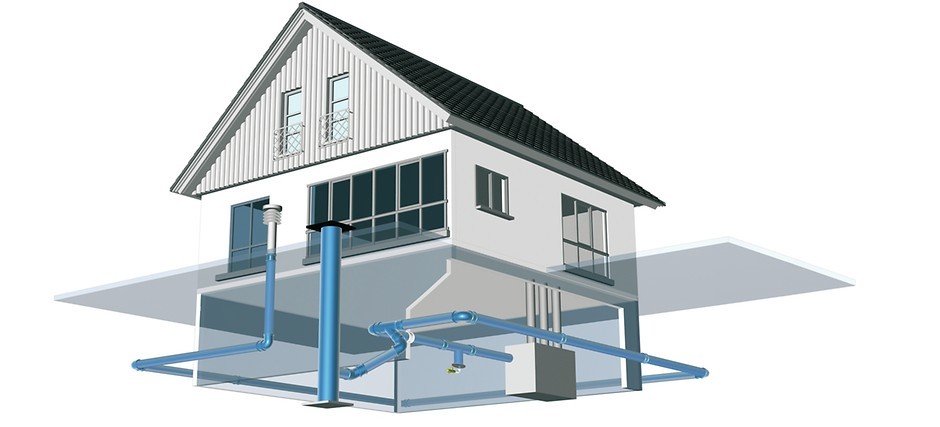
Rehau
+39 02 95 94 11
https://www.rehau.com/it-it/architetti/ventilazione-meccanica-controllataClimatización / Ventilación, refrigeración
The AWADUKT THERMO air-to-ground heat exchanger utilizes the energy storage capacity of the ground to meet the heating and cooling needs of single and double-family houses or industrial and commercial buildings. Designed to integrate with the controlled mechanical ventilation system, AWADUKT THERMO is the first tubular exchanger with an antimicrobial internal layer that provides fresh, healthy air, improving living comfort and energy efficiency in buildings.
The product has been accepted since the design stage, with substantial gains in the summer period where indoor temperature and humidity remain constant around 24.5-25.5 ° C and 45% -55% humidity without the need for additional treatments.
CENTRALIZED VENTILATION EQUIPMENT WITH LWZ HEAT RECOVERY
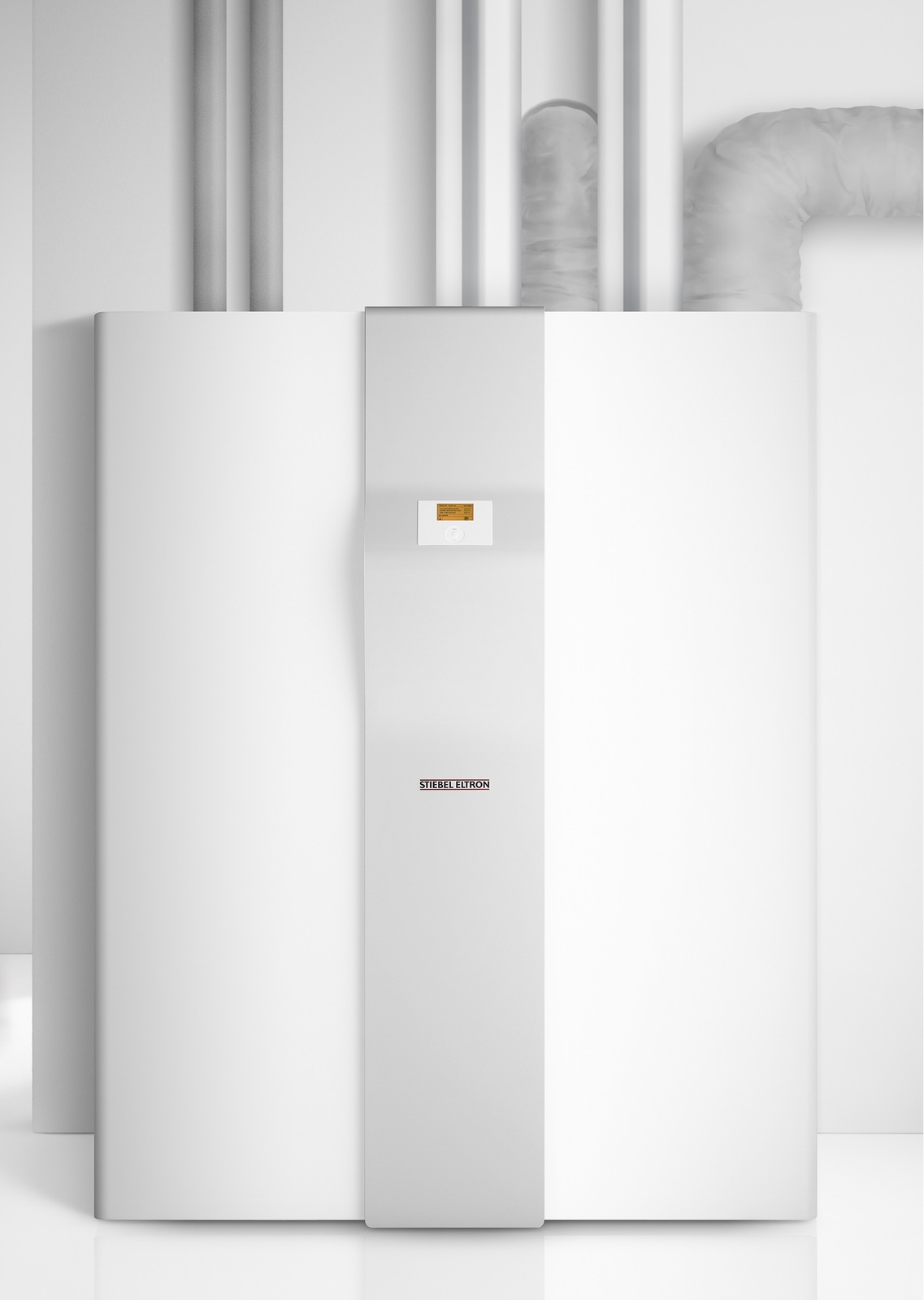
Stiebel Eltron
Enercomb S.r.l., partner ufficiale di Stiebel Eltron per l’Italia | Tel: + 39 030 5311234 | web: www.enercomb.it | E-mail: [email protected]
http://www.enercomb.itClimatización / Ventilación, refrigeración
The compact aggregate Stiebel Eltron LWZ 304/404 SOL is the answer to all the energy demands of an energy-efficient building or nZEB; A high efficiency reversible heat pump for heating, cooling, ACS production, 235 liter hot water storage, and a high efficiency, energy-efficient ventilation unit are integrated. There is also a heat exchanger for the connection of solar thermal panels and the air intake for the VMC exiting from the air-ground exchanger. The level of integration achieved by compact aggregates Stiebel Eltron in over twenty years of evolution allows for a simple and compact installation, maximizing energy efficiency through interaction of the various features and having simple operation with a single panel control. The high quality of the product made it worthy of several certifications, including Passivhaus and Casaclima. Smart Building The compact aggregate Stiebel Eltron LWZ 304/404 SOL can be connected to its home network and to the Stiebel server Eltron allows you to remotely manage your drive over the Internet. You can also talk to a home automation system using the KNX protocol.
The product was selected after a review of what is available on the Italian market in terms of heat pumps and compact aggregates. The initial choice was based on the fact that the Italian market was the only model of this kind that would also have cooled in addition to providing VMC air intake by an air-ground exchanger, so no need to drive Electric defroster on board machine. The product has turned out to be the heart of the house's energy. At the execution stage, the technical room and the cavity plant have been adapted to the spaces needed for this machine. Usage has proved above the average and its operating logic, trivially not an ON-OFF, but based on external and internal average temperatures, makes it possible once you enter the weekly programming that you forget to have it at home.
ISAAC DEVICES
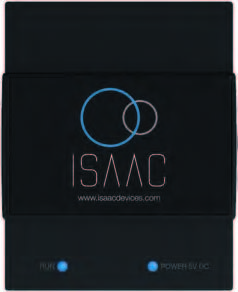
Freedompro S.r.l.
Via IV Novembre 7/a 20037 Paderno Dugnano (MI) | Tel. +39 02 87158121
http://www.isaacdevices.comAcabados / Equipo electrotécnico (corrientes fuertes / débiles)
SMART HOME Global Domotic Supervision, is the heart of Smart Home. ISAAC is compatible with MyHome of BTicino and the KNX world and manages many other components that do not speak the same language in order to command the entire home free of charge. With scenarios that can manually be started by application or automatically by events, geolocation, weather conditions, or shared with other home users, you can manage any present and connected objects to your smart home.
ISAAC was mainly the solution for the management of the 11 sliding windows of the windows and window frames, able to program in a simple and intuitive way the conditions for which in the winter season (when solar inputs are needed) the automatic freewheel opens completely in half In the morning (when the sun rays begin to make an effective contribution to the heating of the room) then to reside horizontally at dusk, while in the summer season slopes are tilted so as not to let direct sunlight pass through the windows of the window frames. The programming was designed by the customer, so each room responded to specific needs; As a result, in bedrooms, for example, programming takes into account occupancy needs before sunbathing. In addition, the programming of the device in spring and autumn limits the solar inputs to a reasonable internal overheating, and then automatically places the lamellas at 45 ° to avoid discomfort for the residents for excessive internal temperatures (26 ° / 27 ° degrees in House at the end of September forgetting open the shingle). Next to the ISAAC, ISAAC has been programmed to automate outdoor lighting, garden irrigation, and so on. Always taking into account the external weather, light and rain conditions, acquired by specific sensors and interfaces installed on the roof of the building.
Construction and exploitation costs
- 360 000,00 €
- 1 230,00 €
- 21 000,00 €
- 210 000 €
- 360 000 €
- 150 000 €
Energy bill
- 720,00 €
Urban environment
The building is located on the edge of the town of Oleggio (NO), in an area characterized by a low building density (B1 area of the PRG) consisting of two-storey detached houses and multi-storey buildings surrounded by green agricultural areas .
Land plot area
910,00 m2
Built-up area
39,56 %
Green space
400,00
Parking spaces
In the project there are 2 covered parking spaces and the possibility of parking additional 3 vehicles in the inner court. There are no car parks or parking spaces on public street Galli. There is a public parking area on the adjacent via Gallarate.
Building Environmental Quality
- indoor air quality and health
- acoustics
- comfort (visual, olfactive, thermal)
- water management
- energy efficiency
- renewable energies
- maintenance
- products and materials




